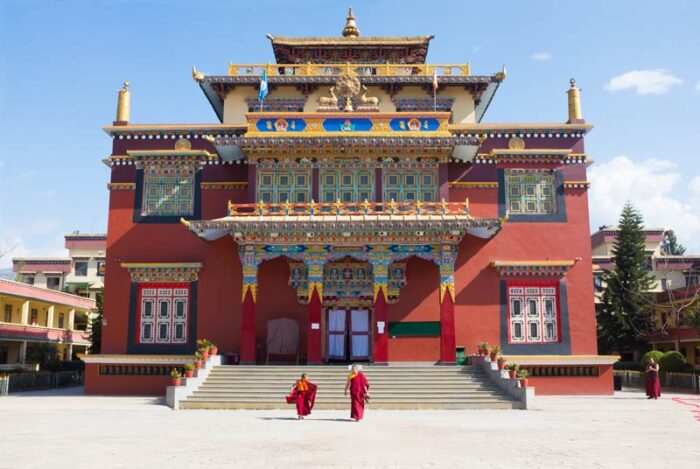In a Buddhist monastery in Nepal a group of seven or eight young monks were making a sand mandala. The mandala was in three levels, a large base level several feet across; another smaller level raised on support legs; and then a third, smaller level above that. I cannot remember what the bases were made of, perhaps thin sheets of wood or metal. But I remember the process they used to make the pattern on the mandala.
The monks were lying down around the mandala, each working on a part of the pattern. Each monk had a small tool that he used to release fine coloured sand in a precise manner. As they moved their tools along, the monks ‘drew or painted’ the sand on the bases, to make one highly detailed pattern in many colours. Mandalas follow an established pattern, which means that the monks are not designing it from scratch, but rather ‘painting by numbers’ as it were, but in sand.
The tool each of them used to release coloured sand was in two parts – a long, slim conical tube and a rod.
The sand was released from the conical tube, which was about a foot long. The coloured sand was loaded into the wide end, and came out of the narrow end. But the hole at the narrow end was extremely tiny. It was so tiny that a monk could ‘draw’ a fine line if he wanted, as he moved the tube along.
The hole was so tiny that the sand did not fall out of the narrow end of the tube under its own power of gravity. It had to be coaxed out of the tube, and for that the monks used rods several inches long. The conical tubes were smooth on the outside except for one section where the surface was made into small ridges and grooves running at right angles to the length of the tube. Together the ridges made a tiny staircase from the bottom to the top of the tool. The monks rubbed the rods gently back and forth over the ridges, and that coaxed the sand out of the tubes so that they were painting with sand.
Now, having got this far you may be wondering why I am devoting so much time to describing the process. Well, first the process is very painstaking and detailed. It takes effort, concentration, and patience to paint the design in sand and to fill in areas of colour with sand coming out of such a tiny hole in the end of the tube.
It is obvious that it would take days to finish. I can’t really remember the speed at which they were working, but maybe it would take them a week to complete it.
And the monks are working very close to one another and have to be aware of each other’s feet and legs and arms or they risk jerking or crashing into one another or the mandala and upsetting the pattern.
In order to make a sand mandala, the monks have to work together. If there was resentment, pride, superiority, or any sense of inequality in the mind of any one of them, it would set up tension. I think that would translate to the work and could be seen in the quality of the work. Pretty soon there’d be an accident and someone would knock against the design. I am sure the monks were all aware of that.
A mandala represents a truth, and its meaning is bound up in Buddhist teachings. Sand mandalas are ceremoniously thrown away, and that impermanence is essential to the purpose of their creation. So what the monks are working on inevitably brings about contemplation of themselves. The process of creating the mandala builds the ability of the monks to form a brotherly relationship. Someone could look at the building of good relationships as incidental to the creation of the mandala, or they could look at it as the very purpose for which the work was done.

.